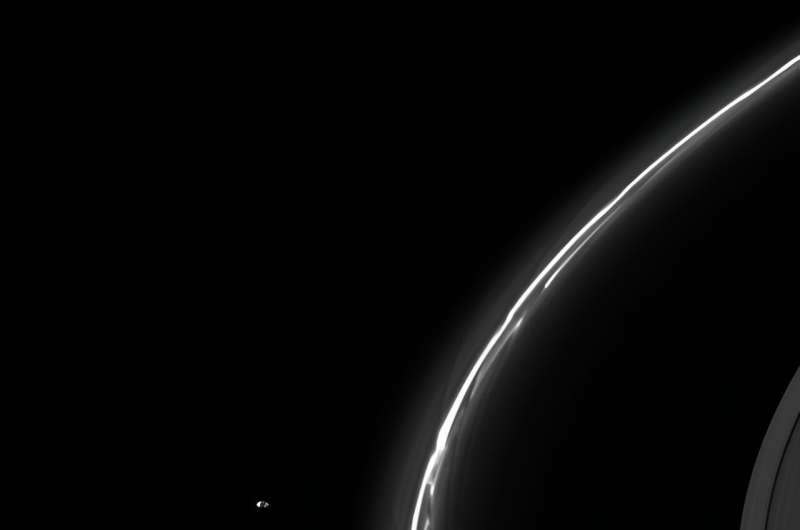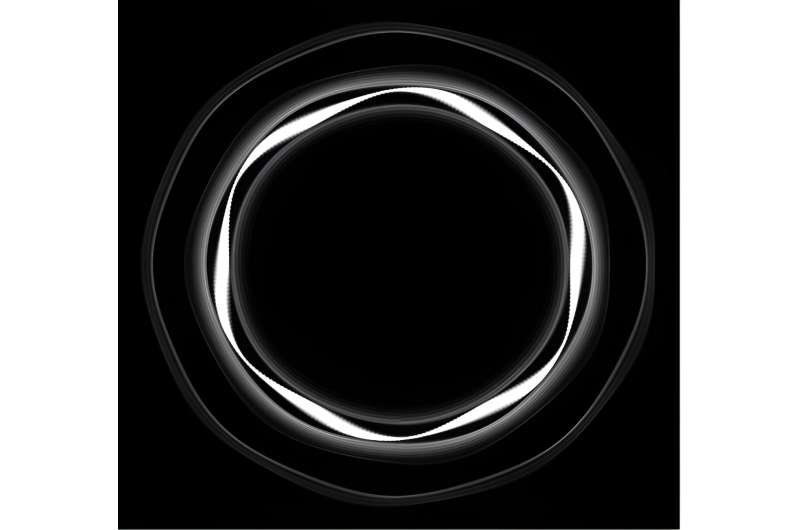This article has been reviewed according to Science X's editorial process and policies. Editors have highlighted the following attributes while ensuring the content's credibility:
fact-checked
trusted source
proofread
Small satellite may shape centaur rings

The unique two thin rings around the Centaur Chariklo could be shaped by an even smaller satellite. Chariklo is a Centaur, which are small bodies similar to asteroids in size but to comets in composition, that revolve around the sun in the outer solar system, mainly between the orbits of Jupiter and Neptune.
"Rings around minor planets have only been recently discovered, and only a small number of such systems are currently known. There has been significant research into the dazzling rings around the giant planets; however, the mechanisms of ring formation and evolution around small objects are not well understood," said Planetary Science Institute Senior Scientist Amanda Sickafoose, lead author of "Numerical Simulations of (10199) Chariklo's Rings with a Resonant Perturber" that appears in The Planetary Science Journal.
"We've shown that one of the possibilities for thin rings to exist around small bodies is that they are being sculpted by a small satellite."
The paper reports the first N-body simulations of a small-body ring system with a satellite. N-body simulations are carried out using computer software to simulate the physical dynamics for a number (N) of components. The results from N-body simulations provide insight into the dynamical evolution of the system being modeled.

In this case, by modeling a few million ring particles in a Chariklo-like system, it's shown that a single, kilometer-sized moon can maintain two rings that have similar properties to those observed.
"We think that the ring particles are primarily made of water ice, like those at the giant planets. We do not know the exact characteristics, such as how 'hard' or 'soft' the ring particles are when they collide or the particle-size distribution. Further simulations can help constrain those properties," Sickafoose said.
"Planetary rings will naturally spread or disperse over time. Chariklo exhibits two thin rings, a few kilometers in width. In order for the rings to stay this thin, there needs to be a mechanism to confine the material and prevent it from dispersing," Sickafoose said.
"We actually show this in the paper by simulating a Chariklo-like ring system that does not have a satellite, and we find that the width of the rings increases linearly with time. This is unlike the situation when there is a satellite in resonance with the ring material, which acts to confine the rings into the km-sized widths that are observed."
Chariklo, approximately 250 kilometers in size, is the first Centaur found to have rings, and they are constrained.
"Our paper shows that Chariklo-like rings can be constrained by a small satellite, one that is roughly 3 kilometers in radius and 1013 kilograms in mass. A satellite this size is below our current direct-imaging limits, so indirect methods or a spacecraft mission would be needed to discover it."
"An alternate mechanism that has been proposed is that Chariklo has a gravitational anomaly on its surface, and the rings are in resonance with the spin of the nucleus; for every three rotations by Chariklo, the rings orbit once. The physics that act on the ring particles are similar for both a satellite or a spin-orbit resonance with a gravitational anomaly," Sickafoose said.
"Interestingly, by most reasonable assumptions, Chariklo's rings are also located near or outside of the Roche limit. The Roche limit is the rough distance beyond which rings should not exist because the material should start accreting into moons—at this distance, the gravitational perturbation from the parent planet is insufficient to shear the particles, and they can form into larger clumps," Sickafoose said.
"A satellite in this situation can perturb the ring material and prevent it from accreting, similar to what is seen in Saturn's F ring."
More information: Amanda A. Sickafoose et al, Numerical Simulations of (10199) Chariklo's Rings with a Resonant Perturber, The Planetary Science Journal, (2024). DOI: 10.3847/PSJ/ad151c. iopscience.iop.org/article/10.3847/PSJ/ad151c
Provided by Planetary Science Institute




















